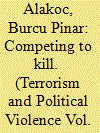|
|
|
Sort Order |
|
|
|
Items / Page
|
|
|
|
|
|
|
| Srl | Item |
| 1 |
ID:
128975


|
|
|
|
|
| Publication |
2014.
|
| Summary/Abstract |
Terrorist organizations do not operate in isolation. Instead, they forge alliances with one another, which generate a tight network of intergroup relationships. We argue that these relationships serve to increase group capacity, manifesting itself in the ability of a group to conduct deadly attacks. However, groups are notably judicious when they forge these cooperative ties, preferring to link to the strongest groups to which they have access. The result of this process of preferential attachment is a core/periphery structure in the broader network of alliances. Moreover, groups with ties to organizations at the core of the broader universe of relationships reap more rewards than those with large numbers of less meaningful alliances. Terrorism research and counterterrorism policy should assess terrorist organizations in the broader context of their interrelationships and depth of alliances rather than in isolation.
|
|
|
|
|
|
|
|
|
|
|
|
|
|
|
|
| 2 |
ID:
152884


|
|
|
|
|
| Summary/Abstract |
Are organizationally linked suicide attacks deadlier than those launched by lone wolf terrorists? This article elaborates a perpetrator-based distinction among suicide terrorist attacks between organizations and lone wolf terrorists, who operate in the absence of a financially or physically supportive terrorist organization. The expectation is that terrorist organizations would serve as commitment tools that increase the loyalty of suicide bombers to their missions through material and non-material incentives. Findings demonstrate that when terrorist organizations are involved in the planning and execution of suicide terrorist attacks, not only do they increase the lethality of these attacks but they also accentuate the tactical advantages of suicide terrorism. These findings suggest that despite the recent upsurge and concern about lone wolf terrorism, the lethality and security impacts of suicide terrorism continue to be driven by terrorist organizations.
|
|
|
|
|
|
|
|
|
|
|
|
|
|
|
|
| 3 |
ID:
120287


|
|
|
|
|
| Publication |
2013.
|
| Summary/Abstract |
The question of whether or not cyber war amounts to war per se is difficult to determine given strategic theory's uncertain grasp of the concepts of force, violence and lethality. These three concepts, along with their relationships with one another, are explored in order to demonstrate that cyber attacks can in fact be construed as acts of war.
|
|
|
|
|
|
|
|
|
|
|
|
|
|
|
|
| 4 |
ID:
098910


|
|
|
| 5 |
ID:
152886


|
|
|
|
|
| Summary/Abstract |
Studies have begun to look at the potentially crucial impacts of group decentralization and inter-group global networking in accounting for the extent and severity of violence in insurgencies and terrorism. Groups may be able to survive more effectively, evade anti-terror or counter-insurgency strategies, and inflict greater damage or more civilian attacks by operating under more or less centralized leadership, or by making use of the resources of other like-minded groups scattered across borders. While some analysts have examined each of these possibilities, few if any have done so simultaneously with both structural and networking indicators or examined the joint effects of these indicators. We propose to do so in this study by combining existing datasets on terrorist structure and networks. Hypotheses and findings in prior studies have indicated that structural decentralization may lead to more civilian attacks if not more destruction since local cells are freer to act on their own, and that group size and centrality in the global terror networks lead to greater lethality and group survival rates. We re-examine such assumptions here with OLS and logit models combining these effects, and find that in addition to group size, network reach (eigenvalue centrality) rather than group interconnections per se (number of allies) appears to have primary impacts on group lethality, targeting, and survival, sometimes in conjunction with decentralized organizational structure.
|
|
|
|
|
|
|
|
|
|
|
|
|
|
|
|
| 6 |
ID:
138074


|
|
|
|
|
| Summary/Abstract |
This paper presents an analysis of the Provisional Irish Republican Army’s (PIRA) brigade level behavior during the Northern Ireland Conflict (1970-1998) and identifies the organizational factors that impact a brigade’s lethality as measured via terrorist attacks. Key independent variables include levels of technical expertise, cadre age, counter-terrorism policies experienced, brigade size, and IED components and delivery methods. We find that technical expertise within a brigade allows for careful IED usage, which significantly minimizes civilian casualties (a specific strategic goal of PIRA) while increasing the ability to kill more high value targets with IEDs. Lethal counter-terrorism events also significantly affect a brigade’s likelihood of killing both civilians and high-value targets but in different ways. Killing PIRA members significantly decreases IED fatalities but also significantly decreases the possibility of zero civilian IED-related deaths in a given year. Killing innocent Catholics in a Brigade’s county significantly increases total and civilian IED fatalities. Together the results suggest the necessity to analyze dynamic situational variables that impact terrorist group behavior at the sub-unit level.
|
|
|
|
|
|
|
|
|
|
|
|
|
|
|
|
| 7 |
ID:
191017


|
|
|
|
|
| Summary/Abstract |
Open-source data and studies indicate the higher lethality rates of jihadist groups versus other types of terrorist organizations. I argue jihadist groups are more lethal than other groups due to their higher ideological intensity, determined by observing how ideology corresponds to a group’s goals, internal cohesion, and external affinity. I use data from the Global Terrorism Database (GTD) and Revolutionary and Militant Organizations dataset (REVMOD) to create two samples of terrorist organizations coded by ideological affiliation. My findings confirm the higher lethality of jihadists in general and of apocalyptic jihadists in particular. Jihadist groups kill more per attack and have higher kill-wound ratios than other groups. Attachment to suicide terrorism largely accounts for higher jihadist lethality.
|
|
|
|
|
|
|
|
|
|
|
|
|
|
|
|
| 8 |
ID:
116341


|
|
|
|
|
| Publication |
2012.
|
| Summary/Abstract |
How does the way in which a group organizes change the lethality of the group's attacks? In this article, we argue that groups organized vertically as hierarchies are likely to conduct more lethal attacks. We build our argument around three advantages inherent to centralized structures: functional differentiation, clear command and control structures, and accountability. We argue that each of these characteristics positively impacts an organization's ability to deliver an effective lethal blow. To test our argument, we use a mixed method approach, drawing on empirical evidence and support from a time-series case study. Our large-N analysis examines the trends in more than 19,000 attacks. In this test we develop a novel proxy measure for hierarchy based on a group's bases of operation and non-violent activities. To complement the empirical work, we examine the history of Euskadi Ta Askatasuna (ETA), the Basque separatist group. Over several decades of violent operations, this group's structure has changed dramatically. We analyze how these shifts impacted ETA's ability to maximize the effectiveness and damage of their attacks. In both the case study and large-N analysis, the more hierarchically organized the group, the more easily the group can orchestrate lethal attacks.
|
|
|
|
|
|
|
|
|
|
|
|
|
|
|
|
| 9 |
ID:
166666


|
|
|
|
|
| Summary/Abstract |
Those who study terrorism are familiar with the claim that suicide attacks are the most lethal form of terrorism today. Suicide attacks kill more people on average than non-suicide attacks, thereby justifying why terrorist organizations use this costly method of attack and explaining in part why suicide tactics have proliferated. However, extant empirical support for this claim is largely insufficient, focusing only on macro-level analysis of lethality data. Using data from the Global Terrorism Database, this study examines variation in lethality among suicide and non-suicide attacks based on geographic location, attack type, and target/victim type. It also introduces a new metric—the lethality ratio—to measure costs and benefits of attacks in terms of lives lost. It finds that, although suicide tactics are generally more lethal than non-suicide tactics, they also come at greater costs to the organization. This analysis also finds behavior that is inconsistent with the premise that terrorist groups are focused on maximizing lethality while reducing costs in all cases; that despite certain advantages, suicide attacks may remain a suboptimal tactic from the perspective of the terrorist group; and that additional criteria may help explain why suicide tactics are used.
|
|
|
|
|
|
|
|
|
|
|
|
|
|
|
|
| 10 |
ID:
122477


|
|
|
|
|
| Publication |
2012.
|
| Summary/Abstract |
The US army continues its transition from operations in Afghanistan and an acquisition strategy designed to provide immediate benefit for the current fight. Nevertheless, hard learned lessons remain at the heat of future procurement, which recalls lessons learned, always acknowledged but perhaps more publicity stated than ever before.
|
|
|
|
|
|
|
|
|
|
|
|
|
|
|
|
| 11 |
ID:
179865


|
|
|
|
|
| Summary/Abstract |
Although a substantial body of research argues that women provide terrorist organizations with important tactical benefits, few studies draw out the implications of this argument or examine whether female recruits affect the outcomes of terrorist operations. Using data on individual suicide attacks from 1985 to 2015, I show that an attacker's gender influences the lethality of an attack. However, this effect is conditional upon the gender norms of the state in which the attack occurs. The results demonstrate that a female advantage is more apparent only in societies where a woman's role in public life is limited; attacks by female suicide attackers are more deadly in countries where women are largely absent from the workforce, civil society, and protest organizations. I also assess whether counterterrorists eventually adapt to the use of female suicide terrorists. The results demonstrate that female attack lethality is declining with time, suggesting that security forces eventually adapt to women's participation in terrorism. These findings are consequential because they highlight the effect of persistent gender biases on counterterrorism efforts.
|
|
|
|
|
|
|
|
|
|
|
|
|
|
|
|
|
|
|
|
|